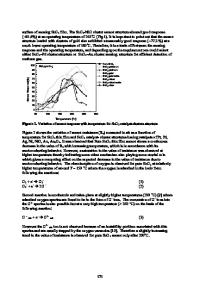Electrospinning SnO 2 fibers with 3D interconnected structure for efficient soot catalytic combustion
- PDF / 3,296,503 Bytes
- 13 Pages / 595.276 x 790.866 pts Page_size
- 36 Downloads / 275 Views
Electrospinning SnO2 fibers with 3D interconnected structure for efficient soot catalytic combustion Silun Zhu1, Shuying Shi1, Yongshuai Xie1, Chonghe Xu1, Xiaoqian Zhang1, Ying Peng1, Xinqiang Wang1,* , Gang Yu2,*, Luyi Zhu1, Guanghui Zhang1, and Dong Xu1
1
State Key Laboratory of Crystal Materials and Institute of Crystal Materials, Shandong University, Jinan 25010, People’s Republic of China 2 School of Materials Science and Engineering, Shijiazhuang Tiedao University, Shijiazhuang 050043, People’s Republic of China
Received: 5 June 2020
ABSTRACT
Accepted: 30 August 2020
In this paper, SnO2 fibers with three-dimensional (3D) interconnected structure were successfully obtained by a simple electrospinning technique with both high quality and reproducibility. The microstructure, physicochemical properties were characterized (FT-IR, XRD, SEM, HR-TEM, TG-DSC, N2-BET, XPS, H2TPR, O2-TPD) extensively. The catalytic activity was tested in temperatureprogrammed oxidation (TPO) of model soot. The influence of the heat-treated temperature on the catalysts physicochemical properties and reactivity was evaluated. The fibers were fluffy and self-supporting after heat-treated which could provide a beneficial environment favored by soot catalytic combustion. SnO2 fibers exhibited good thermal stability in phase structures and morphologies at least 900 °C. The SnF-500 exhibited the highest catalytic activity with T10, T50 and T90 at 410 °C, 450 °C and 474 °C. With the increase in the sintering temperature, the crystallinity of SnO2 fiber increases and the Sn–O-Sn bond strengthens, resulting in a decrease in the catalytic activity of the catalyst as the BET surface area and surface oxygen decrease. Our studies provide insights into SnO2 fibers for soot catalytic.
Published online: 8 September 2020
Ó
Springer Science+Business
Media, LLC, part of Springer Nature 2020
Handling Editor: Gregory Rutledge.
Address correspondence to E-mail: [email protected]; [email protected]
https://doi.org/10.1007/s10853-020-05198-x
16084
J Mater Sci (2020) 55:16083–16095
GRAPHIC ABSTRACT
Introduction The diesel engines have been used due to their high thermal efficiency, low fuel consumption, and excellent durability. However, particulate matter (PM), nitric oxide (NOx), hydrocarbon (HC) emitted by diesel engines are serious risk to both human health and environment, which have attracted extensive attention [1–3]. PM is the prevalent source of air pollution consisted of carbonaceous particles (also called soot) and could cause lung deposition and spread to other parts of the body [4, 5]. To impede the discharge of PM, diesel particulate filter (DPF) has been installed to filter and then burn the accumulated soot particles which could avoid pressure drop caused by clogged filter [6]. The soot particles burn over 600 °C at the DPF system in the absence of catalyst and diesel engines exhaust temperature lies between 200 °C and 500 °C. It is very crucial to introduce the catalyst to burn the soot at the lower temperature which made the D
Data Loading...











